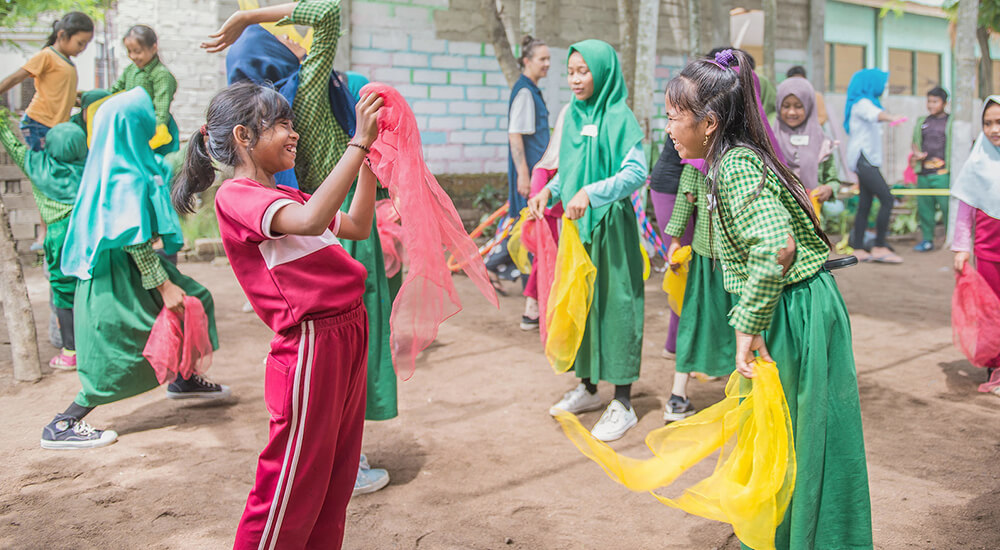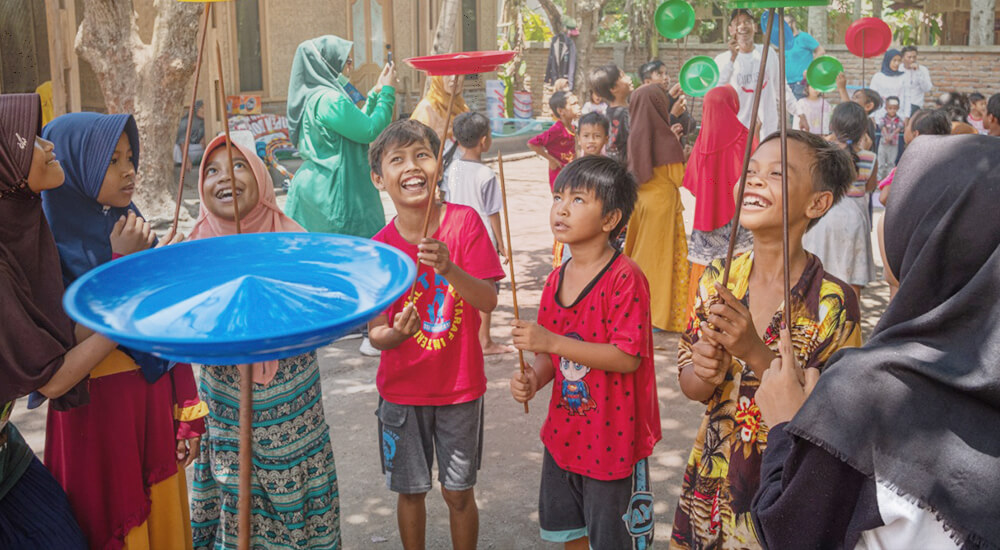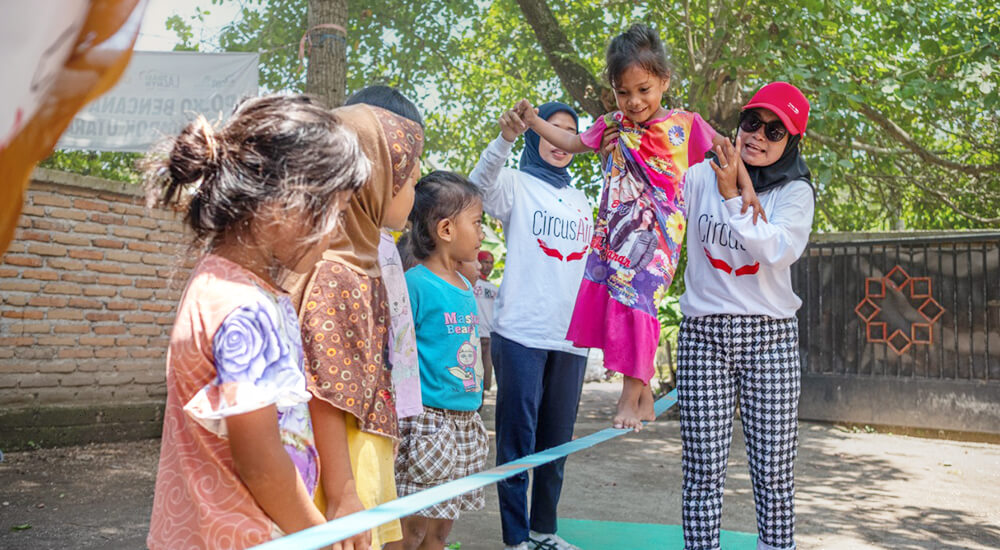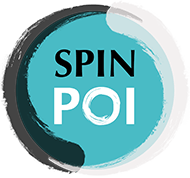The Benefits of Circus Arts as Occupational Therapy Exercises
Founder of Circus Aid Jill Maglio sits down with Dr. Kate Riegle van West of SpinPoi to discuss the power of circus arts to improve wellbeing as occupational therapy exercises.

Jill Maglio first discovered the world of circus in 1999 when she learned poi spinning while attending college in Santa Cruz, California. Twenty years later, Jill is a registered Occupational Therapist and leading expert in working with circus as an educational and therapeutic tool. She is the Founder of two circus/wellbeing initiatives – CircusAid which helps people displaced by war and natural disasters build resilience, mental health and community connection through engagement in free circus arts programs, and Holistic Circus Therapy, a registered and accredited private practice that combines Occupational Therapy with circus arts to address the unique health and wellbeing needs of individuals and communities.
Jill sat down with SpinPoi founder Dr. Kate Riegle van West to discuss her journey with circus arts and occupational therapy, and to share more about the Holistic Circus Therapy method.
How did you first become interested/involved in circus?
Poi was my introduction to circus arts. I learned poi in college in Santa Cruz, California in 1999. In 2000, I travelled to New Zealand to learn more about the origins of poi and the Māori culture. In between WOOF-ing (willing workers on organic farms) gigs, I met other circus people and performers, particularly a group of house truckers on the South Island. They kind of took in my friend and I, we performed fire with them at their events and markets. It was a special community, everyone or had their own truck or moveable dwelling and they caravanned around the island together each with their own unique skill set that together made a unique community. I would say that was my first experience with a community circus without knowledge there was a thing called community circus.

How did you first become interested/involved in Occupational Therapy (OT)?
For a longtime I thought my OT circus journey began by being inspired by fire dancing when I was in college. A couple of years ago I realized it actually happened at a much younger age. As a child I did not exhibit a significant enough disability to be targeted for services, but I had a very hard time focusing in school and I didn’t always “get it”. I would read things over and over and have no idea what I read. When I discovered the world of circus it was like, ‘wow I can focus and this makes me happy’. Traveling reinforced that passion and opened more doors and made me aware of the multitude of opportunities that exist with circus, not just performing but through teaching, sharing skills, co-creating.
Occupational Therapy emphasizes health being equated with a balance of self-care, productivity and leisure. Circus was possibly my first experience of actual balance in that way. Self-care – specifically physical and cognitive health through training poi, hula hoop and juggling. Productivity – I was able to make money and support myself through performance, teaching, and at some points manufacturing equipment, working for Renegade Juggling in California. Leisure – I was surrounded by an international community of people with like interests, we played together, learned from each other, supported each other.
What first prompted you to combine these two disciplines, and what did that look like?
When I went to OT school, I was constantly drawing connections between circus and OT, however it was difficult to study because there were not many educational or therapeutic circus publications in seminal sources at that time. Thanks to Carol McKinstry, one of my professors, I was able to do my final project in OT grad school on the acquisition of life skills that come from engagement in Social Circus programs.
In 2007 I managed a project that looked at the effects of a circus skills programs on young people’s acquisition of “life skills.” Research completed in Victoria Australia in 2005 showed that youth weren’t learning life skills at home or at school which resulted in a state-wide curriculum change to promote ’life skills’ education. A focus group of social circus facilitators from Westside Circus in Melbourne Australia identified these specific skills being addressed and visible in circus activities. Data collected from a combination of this research resulted in the “Circus in Schools” evaluation tool, which is a Likert Scale built to assess the positive impact circus has on the acquisition of life skills for youth in Australia.
After graduating from OT School, I collaborated with a few circus artists who grew up in the Flying Fruit Fly Circus in Australia. We developed a project running 2 circus programs in Cambodia, one with youth who were socially marginalized and one with people who had physical and cognitive learning differences and special needs. This was my first experience as an OT collaborating with people who have grown up training, performing, and teaching circus and it taught me a lot about the potential for these two disciplines to work together. The time in Cambodia was quite exploratory, and the benefits of circus for multiple populations I witnessed during that trip convinced me to further expand my knowledge and OT service using circus as the medium to promote social, emotional, cognitive, and physical health in New York.

What is Holistic Circus Therapy? How did you begin developing this method?
Holistic Circus Therapy is a practice model underpinned by occupational therapy evidence-based practices and theoretical approaches as well as social circus research designed to deliver circus as an educational and therapeutic tool to individuals and communities. The time I spent piloting projects in Cambodia and then working in New York with 3 vastly different populations was integral to developing this practice model because these experiences gave me an opportunity to use circus with different populations of people and see where the similarities and differences were. I was able to test the approaches I was using combine them with occupational therapy practice models and create something applicable for different people who have different goals and needs.
If someone wants to use the Holistic Circus Therapy model in their own work, is there a training program they can participate in?
Yes the Holistic Circus Therapy professional development training is for anyone interested in using circus as an educational and therapeutic tool. It involves research in theoretical and practical tools from occupational therapy, occupational science and social circus. It provides participants with experiential learning opportunities to apply what they learn in simulated real-life contexts through case studies. We address pedagogical tools, learning differences, cognitive perceptual brain functions, motor learning, trauma healing, project management, social enterprise business models and working with a varied of stakeholders and populations for individual treatment, community health and social political challenges.
Can you tell us a bit about your work with poi in particular, and what poi might bring to your practice that is unique?
As an OT what I like about poi is that it addresses so many capacities that are goals for my clients in a fun, playful, creative and engaging way. For example; upper limb strength and mobility, visual perceptual and visuomotor abilities, grasp, dexterity, fine motor wrist strength and flexibility, body awareness and spatial awareness. Adding choreography development address working memory, sequencing and collaboration.
Tell us about one of your favorite projects that you’ve done.
I love all the CircusAid projects I am involved with. I love the multiple partnerships created with a bunch of different professions and people coming together for a common goal. I feel fully energized and grateful during CircusAid projects.
The CircusAid Lombok train the trainer project stands out specifically because we were able to train a group of people from different organisations who then created their own CircusAid Lombok branch. They actually did more CircusAid activities in 2020 than I was able to do. I loved seeing them apply the knowledge and skills they learned needing less and less support from me. It is probably the most sustainable CircusAid project that is becoming increasingly more autonomous in their leadership, funding, project management and facilitations. When I started with this group, I was leading them, facilitating the circus skills and pedagogy lessons as well as creating the lesson plans and for the younger kids involvement for the group to practice their teaching skills. Now, I consult with them about 1 time per month and they are doing the rest on their own. They coordinate their busy schedules and meet for self-directed training, they plan curriculums, run outreach projects within the community, secure funding and organize logistics. I am super proud of the ownership they have taken. The people that funded the Lombok Train the Trainer project last year thought they were supporting 10 people to learn social circus facilitation skills. A year later they have enabled hundreds more to experience the benefits of CircusAid projects including 4 weeks of trauma healing workshops for the kids of the Penjali village in northern Lombok that experienced a disastrous fire last November. The continuation of this project and seeing how it has grown and transferred leadership makes it one of my favorites.

Where would you like to be with Holistic Circus Therapy (HCT) and your other pursuits in 10 years?
I don’t actually think in terms of 10-year plans or even 5-year plans. In my opinion, having a 5-year plan or 10-year plan is brand focused, it prioritizes the success or progress of a brand. I try to be more impact focus, meaning the priority of the work of HCT and CA is in response to current needs, the needs of individuals and groups that utlize HCT and CA services. I don’t believe I can be effective in meeting their needs without doing yearly needs assessment and evaluation of recent projects. This means I can really only project our activities 1 year in advance. This is especially true when dealing with situations such as the refugee crisis, environmental disasters and pandemics where politics and immigration laws are in constant flux. I can tell you where I want to be in one year because that enables me to listen to the needs of the individuals and communities I work with and to plan and direct activities and utilize resources appropriately based on those needs, the most current research and political climate. Using circus to address social justice issues requires having a strategy that takes into consideration multiple concurrent impacts on groups of people. Being impact focused and service recipient focused results in providing effective services that are based on timely information gathering to inform actions. I think trying to strategize the implementation of an effective programs 5 or 10 years in advance would be difficult, convoluted and possibly result in ineffective service or a misuse of resources.
Do you have any advice for someone interested in getting started working with circus arts in a health/wellness context?
Yes, That’s an easy question 🙂 Participate in an Holistic Circus Training. That’s all of my advice, knowledge, skills and experience wrapped in one little 15-hour package.
In one sentence, describe what you love most about your work.
Existing with others in a continuous cycle of being inspired and inspiring.
Want to learn more about the Holistic Circus Therapy Training?
Holistic Circus Therapy is offering certified training accessible online for people interested in teaching circus as an educational and therapeutic tool. Check out the HCT Training learning objectives and curriculum here (please allow a few minutes to load). Dr. Kate Riegle van West will be joining the training as a guest teacher for a one hour segment on how to work with poi as a therapeutic tool including poi history, research, and fundamental poi movements. See the Poi segment description here.
Contact Jill at [email protected] for registration details and to schedule your small group zoom sessions.
